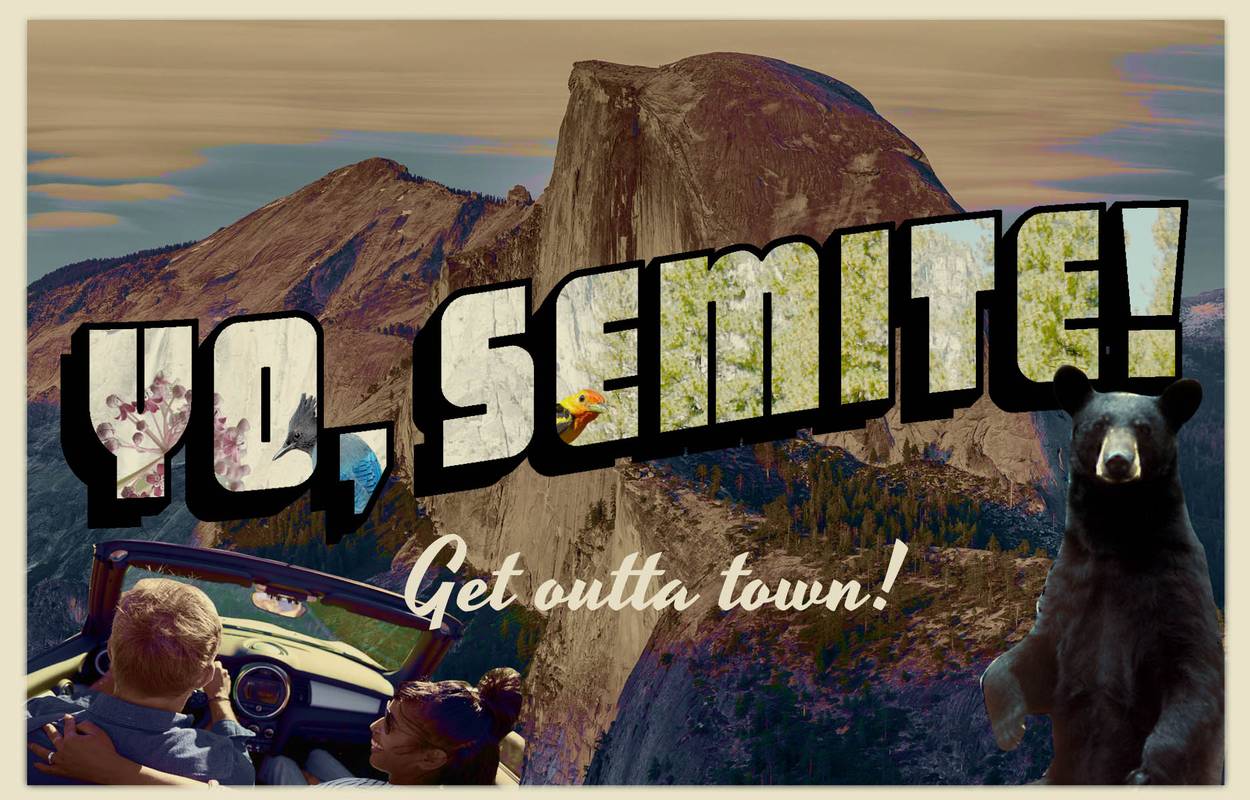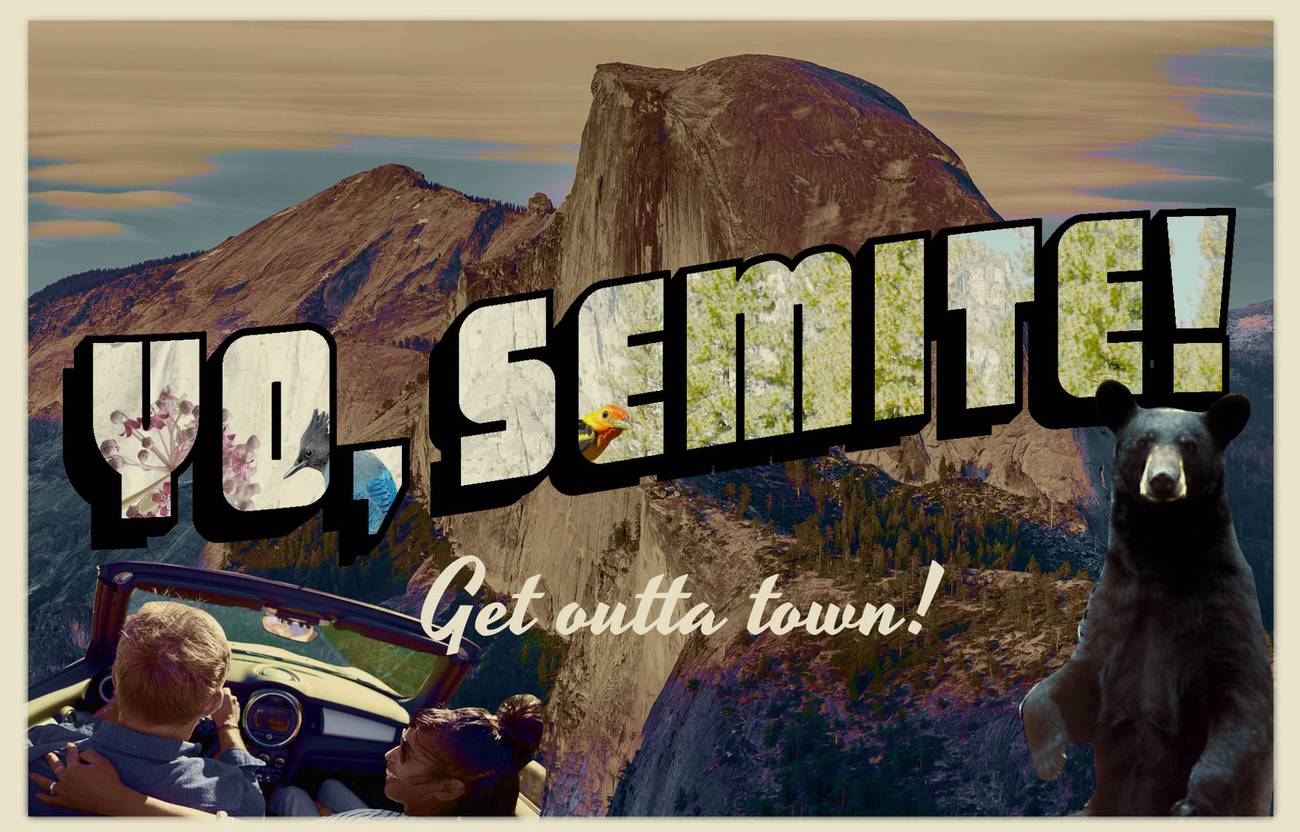Yo, Semites!
An introduction to the National Park System for urban Jews




“When young Americans experience the breathtaking beauty of the Grand Canyon, when their eyes widen in amazement as Old Faithful bursts into the sky, when they gaze upon Yo Semites, Yo Semites towering Sequoias, their love of country grows stronger.”
—President Donald Trump, signing the Great American Outdoors Act
I have never lived in a city with fewer than a million and a half people, and even that seemed kind of small. Like Frank O’Hara, “I can’t even enjoy a blade of grass unless I know there’s a subway handy.” It becomes a stereotype when generalized, but I think of this urbanness as inseparable from my Jewishness. I hate to hike. I have asthma and allergies. But there are few things I love more than the National Park Service.
The Great American Outdoors Act, a bipartisan bill passed this month that secures much needed billions for overdue park maintenance, comes precisely when many of us could really use some time outside.
Even if you can’t leave the city, the National Park Service has preserved America’s Jewish heritage at sites like the Jewish Center of Coney Island, the Albert Einstein house in Princeton, and Boston’s incredibly macabre-sounding Home for Destitute Jewish Children.
So, Semites, yo! Semites! Get out there, take back the treasure that is our national parks. This land was made for you and me.
California
Here’s the great thing about Yosemite: You don’t even need to leave your car. It’s almost better if you don’t leave your car. There are no hikes to speak of: Most of the valley floor is blanketed with asphalt, and shuttles ply back and forth between waterfalls, snack bars, and parking lots. California’s drive-through sequoias may have toppled, but that roof-down, cat-eyed-sunglasses feeling is still there: a merger of pristine nature and a strip mall. This sounds like a dis, but it’s actually the highest compliment I can give. I love strip malls.
The best view of the park—the postcard view, the Ansel Adams view—is only accessible by car. You drive along Highway 41, enter the Wawona Tunnel, and into focus comes “Tunnel View.” The effect is like a photograph developing: the pinhole of light expanding as the view comes into focus. It’s breathtaking.

The sheer face of the massif El Capitan stands on the left, the sloping shoulders of Half Dome straight ahead. Glacier Point, where John Muir took Teddy Roosevelt to camp, is about an hour’s drive from the valley floor.
Not only is this a boon for social distancing, but it also means that the park is one of the nation’s most accessible for seniors, wheelchair users, or those of us who would just rather sit in the air conditioning.
Fees: $35 per vehicle
Note: Anyone over 62 can buy a lifetime National Parks Senior Pass for 80 bucks and everyone else in the car gets in free, too. I can’t get over how great a deal this is.
Nearby Jewish Communities: Bay Area, 170 miles
Current Status: Open—reservations required
New Mexico
Why am I recommending a national park that is currently closed? Because every night at sunset, rangers turn on a sonar, and the cave resounds: a few clicks at first, then faster, and then almost a million palm-size bats swarm overhead in search of their evening meal.
Rangers spend most of the evening program (now broadcast for your car stereo) interspersing expectations-management with bat facts: “Just a reminder that there may be no bats tonight, we can’t control the bats [nervous laughter], did you know that each of these million bats will eat about 1,200 insects in a night?”
When the bats arrive, it is amazing. The combination of the sunset spreading across the huge Southwestern sky and the dancing of a black cloud of bats into the distance is so magical I’d say it’s worth the trip on its own.
If the caverns aren’t your thing, head over to White Sands. There’s really only one vista, but what a vista: The rolling dunes of sparkling white gypsum stretch surreally out to the horizon. When we had only been dating a few months, my now-husband found a huge gold and tourmaline engagement ring glinting in the shifting sands and I thought he was proposing. No guarantees you will be so lucky. In the deep blue of evening, White Sands is the selfie backdrop that dreams are made of. Buy a sled in town and go nuts.
Fees: Cavern, $15 per person
White Sands, $25 per vehicle
Nearby Jewish Communities: Santa Fe, 233 miles to White Sands
Current Status: For the protection of the bats, the official viewing is closed but the ranger program is available by radio. The cavern is open. White Sands is open with limited facilities.
Alaska
The crazy thing about Denali is that they are practically begging you to go off the trail. My brother and I waited in line at the visitor center to ask about a “safe hike,” a habit we learned from our dad. (It was my dad who once gifted us the account of a 12-year-old boy, lost for two weeks in the backwoods of Maine, in anticipation of a trip to Acadia.)
But at Denali, the ranger’s suggestion was to leave from the visitor center and walk “in any direction that looked good.” After hiking down into a braided riverbed and up a mucky gulch, my brother set off to explore an adjacent ridge. “Hey!” he yelled, his voice carried off by the wind. “I think it’s a grizzly den!” I wondered, as I swatted fat mosquitos, about the fundamental differences between siblings, how we can share parents and DNA and yet one of us can enter into a presumptive bear den, bedded down recently with fresh scat, and the other can end up praising Yosemite for its pavedness.
Let me give you some free Alaska advice: If you run, the bear thinks you’re prey. The best bet is to not see the bear at all.
Fees: $15 per person plus additional bus fees
Nearby Jewish Communities: Anchorage, 233 miles
Current Status: Open, with some areas closed during the pandemic
Arizona
You don’t need me to tell you to go to the Grand Canyon. It’s the Grand Canyon! You can see it from space!
Fees: $35 per vehicle
Nearby Jewish Communities: Flagstaff, 80 miles; Sedona, 114 miles
Current Status: partially open
Virginia
Storing stuff with generous friends and family up and down the Eastern Seaboard in your 20s means that in your 30s, you are going to have to go and pick it up. I-95 is convenient, but it is so miserable. You realize that, while renting a U-Haul and moving yourself does save you money, money isn’t everything. Switching to the Blue Ridge Parkway and taking the Virginia section along the Shenandoah National Park’s Skyline Drive gives you far and away the best hours of the whole trip, even if the speed limit is, in miles per hour, 35.
How can you be hugging the side of the Blue Ridge mountains looking out over the gentle rolling forests of sugar maples and pines and also be so close to the gridlocked D.C. sprawl? It doesn’t seem possible.
Fees: $30 per vehicle
Nearby Jewish Communities: Northern Virginia, 55 miles
Current Status: Phased reopening
California
The joke about Southern California, that you can go skiing and surfing in the same day, is taken to its most metal conclusion in Death Valley, national park of extremes.
At the salt flats of Badwater Basin, it is hot: so hot that your muscles go to jelly. The salt flats are blindingly white and crispy under your soles; your brain itself starts to reverberate a little. In 1913, the valley floor set the world record temperature of 134 degrees. One time, the heat melted the industrial glue on my car and we drove with the plastic trim flapping, blap blap blap blap blap, all the way back to San Diego.
But then you climb Dante’s Peak, the highest mountain ringing the basin (by car! who are we kidding!) and it’s cold, really genuinely cold, and you wish you had a heavier jacket.
As for the rest, it’s that desert weirdness of rusted-out abandoned cars, sunbaked lizards, cowboy-size steaks, coyotes, and stars. God, I miss Southern California so much. Pro tip: Bring more water than you think you need.
Fees: $30 per vehicle
Nearby Jewish Communities: Los Angeles, 258 miles
Current Status: Phased reopening, limited facilities
Wyoming
By now, you find visiting national parks calming, almost ritualistically reliable. The rangers’ uniforms with their poorly fitted pants and awkwardly perched hats, the privatized gift shops with similar wares, a fresh batch of junior rangers being sworn in over the loudspeaker. Yellowstone, America’s first national park, symbolizes all of that.
The 1920s stone-and-log Old Faithful Inn is right across from the geyser; you can watch it go off around 20 times a day. (Please, though, go in the off season, to avoid crowds this year!)
The real greatest hit of the park, for me, are not the geysers but the hypnotic hot springs, colored like agates by iridescent bacteria of deep blue, green, and gold. It remains a terrifically bad idea to try to dip a finger in (I’ll leave you to Google that one), but I understand the impulse, like wanting to eat lava. It’s the core of the Earth talking directly to you: immediate, visceral, and primal.
Fees: $35 per vehicle
Nearby Jewish Communities: Denver*, 507 miles. *Update: The Jackson Hole Jewish Community writes in to Tablet indignantly to note you are welcome there, much closer than Denver, just south of the park.
Current Status: Open, limited services
Lily Kelting is an assistant professor of Literary and Cultural Studies at Flame University in Pune, India. She is a former editor at TheaterForum magazine and Exberliner magazine.